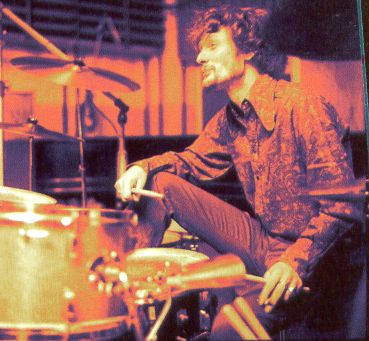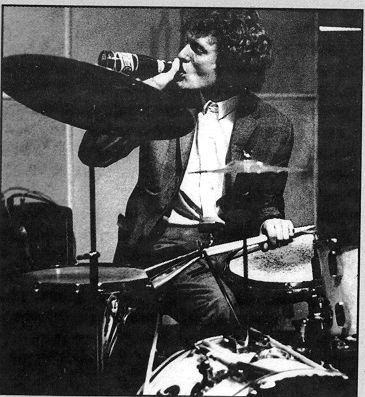
The early Cream drumming is not a significant advance on the Klooks Kleek days except for modest increase in the use of cymbals and toms, which is as one would expect. Jack and Ginger play fairly tightly as a rhythm section behind the lead guitarist. On the Marquee and Barbecue bootlegs of May '67 there is a noticeable spreading of the drum sound. Songs such as "Sunshine" and "We're Going Wrong" allowed Ginger to move to an equal lead role - the runs and patterns used in Toad are beginning to appear in the instrumental breaks. The drum sound on the Barbecue boot is awesome. Ultimately it was going to be the move away from the song form (verse/chorus/solo/verse/chorus) that would enable Ginger to develop a whole new style of drumming.

For the US tour beginning in August, he further upgraded his kit by adding a greater array of cymbals (most of them he still possesses - "they get better with age"). The drum array was now augmented by a comparable array of cymbals on double tier stands. Such a variety of cymbals is now standard even in Jazz. The array was now: 13" high-hat, 14" crash, 18" crash (both left double) 16" crash, 20" ride, (both right front), 22" riveted crash-ride, 20" crash (right back), on three double tier stands, 8" choke (splash), cow bell (note this probably varied over time). The large riveted crash-ride became a staple of his cymbal sound, and remains so to this day, as it cut through the volume of the now dual stacks. The power of this kit was going to be needed in the larger US venues.
At the Fillmore in August the lead guitarist's solo's began to extend - Baker and Bruce responded like jazzers and moved to more free form playing. All three were now so attuned to each other that they all soloed in ensemble: the guitar tearing over the rampant syncopating bass and drums. With lesser musicians it could, and usually did, fly apart but these three were now at their peak. They had been searching for a door, they found it and all three charged through it.
At this time Ginger Baker became the most influential drummer in Rock music. To the American rock/pop drummers (mostly Jazz drummer influenced) he showed that you could play like a jazzer in the Rock environment, you could be front line and you could be a star. And who was influenced - Carmine Appice for one whom quickly expanded to a double kit. The impact flows through to today in such players as Alex Van Halen and Lars Ulrich.

No one tells Ginger Baker what to play! He works out what he will play within the context of the arrangement. He sees the pop song as a musical arrangement and does not improvise or rigidly repeat on take after take until its "right". Once he defines his drum arrangement he plays it, gets a good take and that’s it, finished (a totally unacceptable approach these days). In the pop context he leaves it to the rest to overdub/redub unless he’s arranging/producing. With Cream he departed off to the bar in the basement of the Altantic Records building. The great example of this is "White Room" where it is only the drums (plus some of the bass line) that was retained from the initial version to the released version!
In the live context Baker improvised – even in the song section where he would do subtle variations and especially accent shifting. At the Fillmore in August ’67 he moved to full jazz improvisation with an enhanced approach. He had now developed his technique to fewer subtle strokes, such as light snare riding, and using power stokes distributed across the kit. The triplets, flams, ruffs and tom runs he uses in Toad were laid out and integrated into the jam simply by leaving strokes/beats out. Check out the videos and you will see him playing a pattern and simply stopping a stroke before it hits the batter. All this is further accentuated with the interplay of hi-hat and left bass plus the tonal variety of his cymbal array. Baker became a percussion section giving almost equal weight to each component, even the cowbell. Coupled with Jack’s quasi rhythm guitar playing, Cream sounded bigger and louder than a trio.
Within these extended improvisations Baker brought forward the full armoury of his technique that he had largely honed on the massive kit via Toad:
The triplet runs on the toms were extended, building extended coherent musical passages
The 2nd bass drum entering to reinforce a power passage or add variety to a quieter passage
Multiple crashing/riding of cymbals at musical climaxes
Building complex rhythmical patterns using such rudiments as Flams and Ruffs
Hi-hat holding the beat and often between the beat
The 20" kick driving the jams on and on
The magnificent Leedy wood snare just cutting through the din - releasing and tensioning the snare to superb effect
Goosing Clapton when he starts to slide into blues noodling
Pulling Jack into line when he goes too far out
The full kit used to maximum musical effect while instantaneously responding to the rapidly changing dynamics, as well as contributing a third of that dynamic.
It is the jam drumming that holds the most interest. The solos remain something for drum connoisseurs though jazz aficionados would find them somewhat dull. And that holds true for all of Cream's music due to its harmonic and rhythmic limitations. However the approach of collective high power jamming and extreme volume still manages to overwhelm: "Cream's sound is just this side of physically tangible. It assaults, drowns, lifts, transports, and when it stops, one feels alone, insufficient somehow." (Alan Heineman, 'Downbeat', June 1968).
Cream's jams, at their best, have never been matched, in terms of collective improvisation, in Rock Music. The key to this remains the drumming as Baker refuses to play the role of rigid time keeper. He instead provides a swinging power style more reminiscent of the Big Band drummers than be-bop.. It is this ability to solidly swing ie laying down an implied beat while still playing free time, that holds the jams together. The swing is the thing.

© Graeme Pattingale, 1999
Updated Jan 28, 2001, © Graeme Pattingale, 2001
Principal Sources: John Platt, "Disraeli Gears", Chris Welch, "Cream: Strange Brew", Chip Stern and various Ginger Baker interviews.